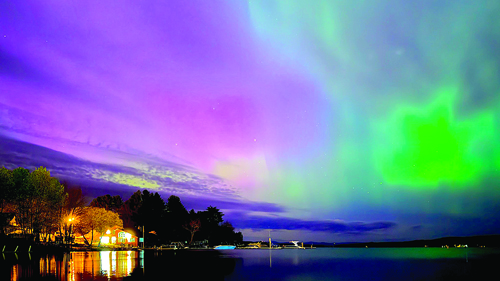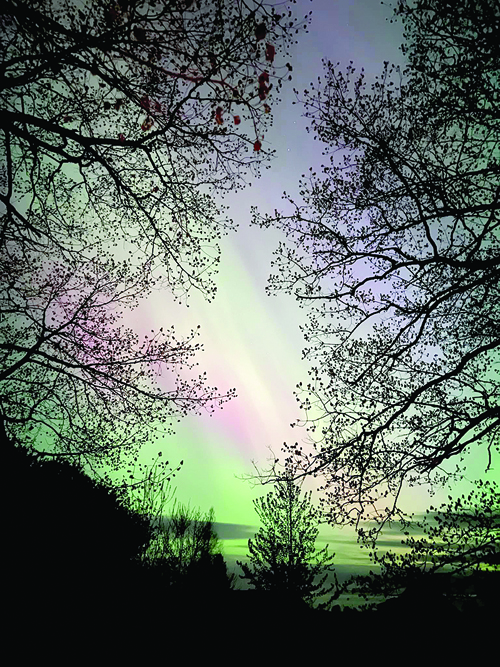In Ye Olden Times: The Northern Lights

By Michael Davis
Guest Columnist
Howdy neighbor!
Some skies we’ve had this past week, eh? Certainly, one for the record books — more auroras sporting in the skies over Bridgton, and indeed all of Maine, than I’ve seen in my lifetime. Not since I was a boy have I seen anything even approaching the grand display of Northern Lights that we were treated to last Saturday night, and I hear spectral traces of these lights continued to show up here and there across the state in the nights afterward. Down to Standish, over 100 people gathered at the boat launch to take in the green and purple fires hanging over Sebago, and some of the pictures coming out of Portland and the islands of Casco Bay are truly stunning.

Going back through the files, we’ve witnessed many an auroral display here in Bridgton in years gone by, and while I was tempted to pull up some obscure piece from the 1870s — those grand old days when we didn’t yet know just what those mysterious glimmerings up there really were — I thought instead that it would be of more interest at this time to recall an event which many of our readers will doubtless still recall. For as it happens, The Bridgton News of July 15, 1982, bears the singular item; “Spectacular Northern Lights — Bridgton was treated to a great spectacle on Tuesday evening. Northern Lights literally filled the sky.”
Luckily for us, other papers in Maine had more to say on the matter, which seems to have been at least as widespread as the recent bout, and which received full coverage throughout the length and breadth of Maine. I take you now to the report of the Bangor Daily News of July 15, 1982, in its interview with Dr. Neil Comins of UMaine at Orono:
“Aurora Borealis washes night skies — Maine was crowned Tuesday night in an unusual 360-degree display of the aurora borealis, or northern lights. The configuration of the light display over Maine Tuesday is called an auroral corona, since the rays emanating throughout the atmosphere appeared to converge at a central point directly overhead.

The aurora borealis light displays once were thought to be sunlight reflected from the polar icecaps. In reality, they are caused when particles bombarding the upper atmosphere begin to ionize or strip electrons from atmospheric atoms and molecules. The displays of light arc as they conform to the magnetic fields surrounding the earth.
The bottom of the rays stretching across the sky are rarely lower than 65 miles above the Earth’s surface, although they can dip to within a few miles of the Earth’s surface. The tops of the rays generally are 100 miles high. The most active and rapidly changing rays are relatively thin, whereas the most stable rays can be up to 2 miles thick.
Dr. Neil Comins, director of the observatory and planetarium at the University of Maine at Orono, explained Tuesday night that the colors displayed in an aurora borealis vary depending on the energy of the particles that seep through the Earth’s protective Van Allen belt and cascade through the upper atmosphere. Comins said the shapes displayed by the aurora borealis vary with the fluctuating shape of the Earth’s magnetic fields.
Telephone calls began lighting up the Bangor Daily News switchboard just before 10 p.m. Tuesday to ask what the lights in the sky were. By 10 p.m., the aurora borealis shone in full glory, washing the state in shimmering sheets of light. Dozens of people called city officials as far south as Portland to ask for explanations of the strange curtains of light. Clouds obscured the celestial spectacle from the view of residents in the northern part of the state.
Dr. Comins said the aurora borealis is very common — almost a daily occurrence — in the far north. As far south as Maine, Comins said, the phenomenon is visible perhaps 10 times a year. Comins said the aurora borealis can occur at any time of year, but said that in his experience it more commonly appears in the fall and in the winter. Comins said the aurora borealis occurs more frequently and more dramatically during periods when the sun is very active. During periods of high solar activity, Comins said, the sun’s flares are more violent and larger and the sun emits more highly energized particles than it does during periods of low activity. Those particles, he said, overload the earth’s magnetic shield and result in the display of northern lights.
The sun, he explained, is on an 11-year cycle, during which it goes through a peak and a valley of activity. He said the sun was at its most active point in its cycle about two years ago and is still in an active phase. Comins characterized Tuesday night’s display of the northern lights as one of the more dramatic examples of the phenomenon that he has seen.”
And as for more on the 1982 sightings here in Bridgton, which I’m surprised didn’t get more of a write-up at the time, several years ago I saved a clipping from the Portland Press Herald of September 12, 2014 in which Portland meteorologist and frequent weather columnist David Epstein gave a brief account of the display, which he saw here in Bridgton while working as a counselor at one of our local summer camps. Epstein recalled, “Back in the summer of 1982, I woke up about 50 campers to see the Aurora Borealis display in Bridgton. That summer was the first time I personally ever saw the display and some of those kids still talk about that night 32 years later.”
So, to close out for today, I’d like to ask our readers, if you were one of these campers, or if you have any particular memories of this event you’d like to share, I’d welcome you to write in a Letter to the Editor with your stories. I’m sure we’d all love to hear them, and I can promise to save and archive your account for posterity.
Till next time!

